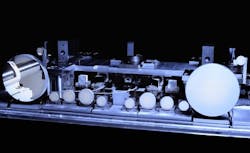Refraction of gamma rays in silicon opens the way for gamma-ray optics
Garching, Germany and Grenoble, France--A team of European researchers has discovered "significant" refraction of gamma rays by silicon.1 The scientists, from Ludwig-Maximilians-Universität München and Max-Planck-Institut für Quantenoptik (both in Garching, Germany) and the Institut Laue-Langevin (ILL, Grenoble, France), placed a silicon wedge in a flat double-crystal spectrometer and measured the amounts of refection for gamma rays ranging from 0.18 MeV to 2 MeV in energy.
Their discovery overturns decades of theoretical predictions and opens the door to nuclear photonics. Gamma-ray microscopes could remotely scan for dangerous nuclear material in ships or trucks, monitor nuclear waste, or provide selective, less destructive medical imaging for cancer diagnostics and treatment.
The ILL houses one of the most intense gamma ray sources in Europe, as well as a suite of highly sensitive instruments to measure refraction very precisely. The gamma rays produced using ILL’s PN-3 facility were sent through two silicon crystals, the first pre-selecting them as they came out of the reactor and directing them into a very narrow and parallel beam. Further along the instrument, a silicon prism was placed at a height where it refracted half the gamma-ray beam. The refraction of this half-beam was then detected by a second silicon crystal and compared with the half consisting of unrefracted gamma rays.
What the researchers found was that, as the energy of the gamma rays increased, the decreasing refraction values, which had actually declined to small negative numbers, suddenly flipped sign and increased toward larger positive refraction values similar to those for materials used with visible light. The researchers now believe that by replacing the silicon prisms with higher-refracting materials like gold, they can bring refraction up to a level where it can realistically be manipulated for optical techniques.
Potential applications include:
• More-selective and less-destructive medical-imaging techniques achieved by enriching a particular isotope in a cancer and monitoring where it goes
• Improved production and testing of new, more-targeted radioisotopes for cancer treatment
• Remote characterization of nuclear materials or radioactive waste
The announcement that the Extreme Light Infrastructure Nuclear Physics (ELI-NP) facility in Magurele, Romania will contain a new higher-photon-energy gamma source has re-triggered interest. The ILL colleagues believe that their discovery could improve the sensitivity of experiments at ELI by three to six orders of magnitude.
REFERENCE:
1. D. Habs et al., Physical Review Letters, 1 May 2012; DOI: 10.1103/PhysRevLett.108.184802

John Wallace | Senior Technical Editor (1998-2022)
John Wallace was with Laser Focus World for nearly 25 years, retiring in late June 2022. He obtained a bachelor's degree in mechanical engineering and physics at Rutgers University and a master's in optical engineering at the University of Rochester. Before becoming an editor, John worked as an engineer at RCA, Exxon, Eastman Kodak, and GCA Corporation.
